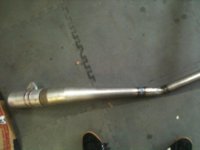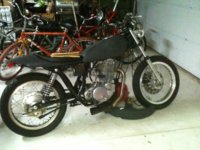It helps to not think in terms of "port" verses "tubing". The tube becomes the port. You do not introduce tight radius for the same reason you do not do it in the ports. The only way to overcome the loss, especially in the transition area and the first 6-8" of the header, is by using larger tubing diameters. And the problem keeps going down the toilet. "Well, if we made a bigger header, it would make a little more power",(because we overcome the flow loss up front). But the larger tube now needs an even tighter radius to clear the obstruction... And you are now so far away from what the engine wants for a header, it really does not matter what you do from there, the engine won't respond to changes.
The smallest diameter tube allows for the largest radius. It can even be smaller in area than the port, especially if it allows a larger radius. (the application can trump this though)
The first 6-8" of the header is just as important as the first 3 or 4" in the cylinder head. The same rules and thinking that a head porter uses apply to the header. Most headers I see break all the rules.
The last thought is this, the reason the first 10" of the exhaust track is so important as opposed to just the port in the casting? The gas particles, the mass...only gets that far before the ex valve closes behind it, and it no longer is connected to its pressure differential, if you will. At that point in the exhaust track, everything changes. But anything you do to the "particulate-mass" flow in the port while the valve is open that violates flow, will cost you power and you can not get it back. You want to get the "mass-flow" as far away from the ex valve and the cylinder as you can. Larger "anything" in this area does not usually help.
I do understand that many applications force the header to break all these rules and larger is the only answer if you need maximum power.








